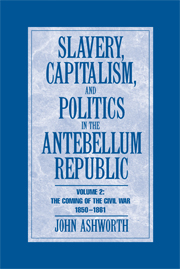Book contents
- Frontmatter
- Contents
- Acknowledgments
- Introduction: Explaining the Civil War (1)
- Part I Slavery versus Antislavery
- Part II Polarisation and Collapse
- 3 The disintegration of Democratic hegemony: Northern Democrats and their southern allies, 1850–1861
- 4 Political realignment: Collapse of the Whigs and neo-Whigs, 1848–1861
- Conclusion: Explaining the Civil War (2)
- Appendix: A review of some major works on the reasons for Confederate defeat
- Index
4 - Political realignment: Collapse of the Whigs and neo-Whigs, 1848–1861
Published online by Cambridge University Press: 05 June 2012
- Frontmatter
- Contents
- Acknowledgments
- Introduction: Explaining the Civil War (1)
- Part I Slavery versus Antislavery
- Part II Polarisation and Collapse
- 3 The disintegration of Democratic hegemony: Northern Democrats and their southern allies, 1850–1861
- 4 Political realignment: Collapse of the Whigs and neo-Whigs, 1848–1861
- Conclusion: Explaining the Civil War (2)
- Appendix: A review of some major works on the reasons for Confederate defeat
- Index
Summary
Introduction: Whiggery, neo-Whiggery and their discontents
On June 29, 1852 Congress assembled and then immediately adjourned. The reason was that one of its most illustrious members, Senator Henry Clay of Kentucky, had died. Over the next days and months eulogies were pronounced on Clay, one of them, thought by some to be the best, by New York's Senator, William H. Seward, another by Abraham Lincoln, the little known, single-term Congressman from Illinois. By 1860 more than forty towns and counties had been named after the Kentuckian and there were monuments to his memory in cities north and south, east and west, a testament to his popularity throughout the nation. On his death Clay became the first American to be honoured by having his body lie in State in the Rotunda of the Capitol.
Almost four months later the nation heard that Clay's long time Whig ally and rival, Daniel Webster of Massachusetts, had died too. Again there were outpourings of grief across the nation. Webster had by the time of his death won considerable respect and admiration in the South. Elsewhere in the nation he had long been venerated as, with Clay and John C. Calhoun, one of the greatest statesmen of his age, an orator of unsurpassed power and an adornment to the nation.
Clay and Webster were acknowledged as the great leaders of the Whig party, even though neither had realised his all-consuming ambition of winning the presidency.
- Type
- Chapter
- Information
- Slavery, Capitalism and Politics in the Antebellum Republic , pp. 471 - 627Publisher: Cambridge University PressPrint publication year: 2007



